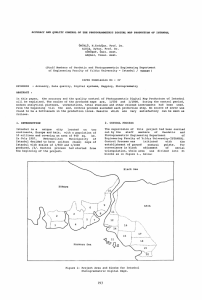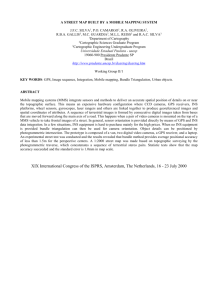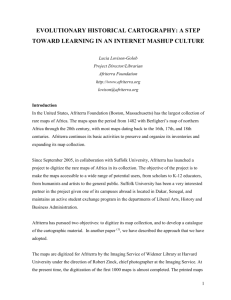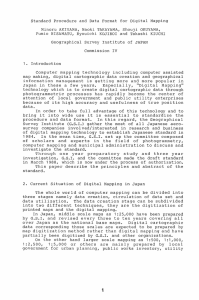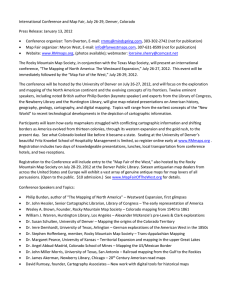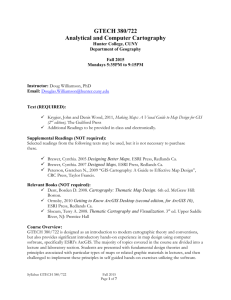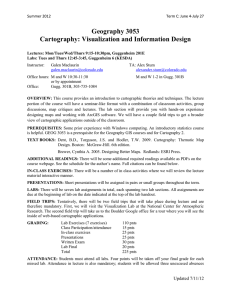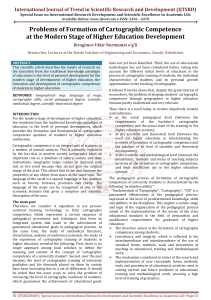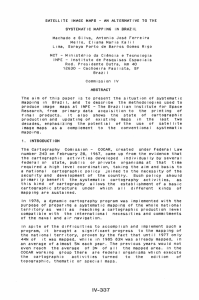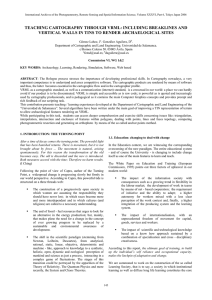14TH CONGRESS OF THE INTERNATIONAL ... PHOTOGRAMMETRY Hamburg, 1980. Commision IV
advertisement
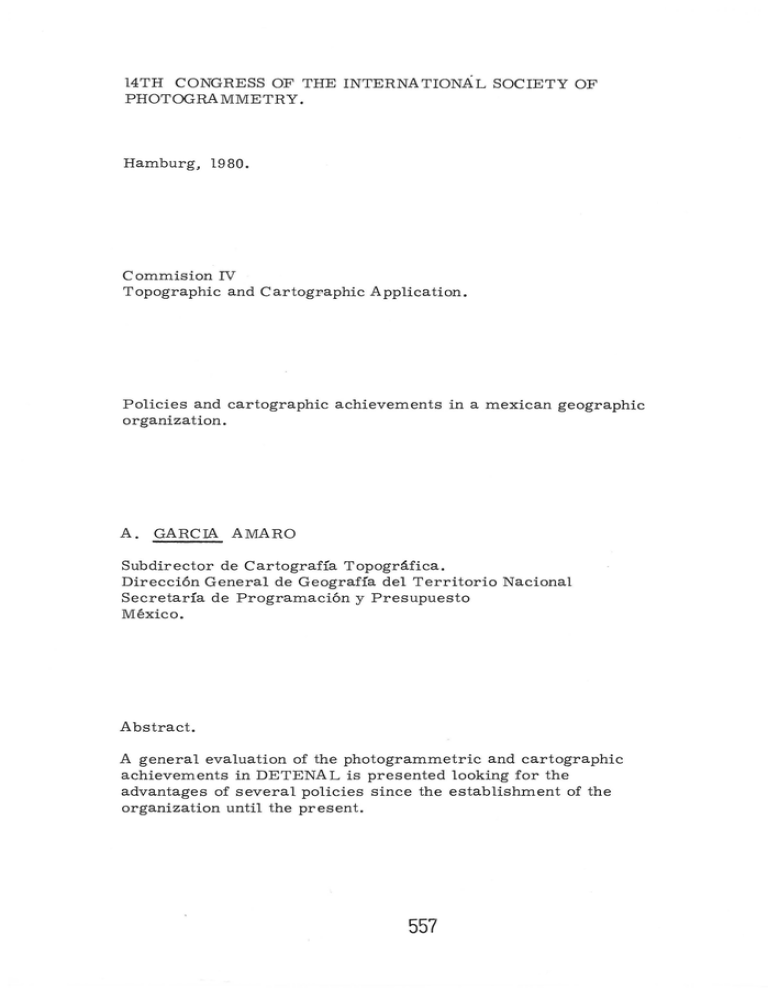
14TH CONGRESS OF THE INTERNATIONAL SOCIETY OF PHOTOGRAMMETRY . Hamburg, 1980. Commision IV Topographic and Cartographic Application. Policies and cartographic achievements in a mexican geographic organization. A. GARCIA AMARO Subdirector de Cartografia Topografica. Direcci6n General de Geografia del Territorio Nacional Secretarfa de Programaci6n y Presupuesto Mexico . Abstract . A general evaluation of the photogrammetric and cartographic achievements in DETENA L is presented looking for the advantages of several policies since the establishment of the organization until the present. 557 At the mexican cartographic organization has been stablished a topographic cartographic system; it includes as main products the followin scales. 1: 5 million 1· 1 million 1: 250 000 1· 50 000 1: 20 000 1: 10 000 The small scale maps are completed for all the territory (two millions square kilometer) : the 1: 250 000 topo map is at 70% of advance and it is hoped to compleet the first coverage in 1981. With respect to the 1: 50 000 topo map, a typical photogrammetric map, there have been produced 1800 sheets, more than 7 5% of the territory; we remak that our territory has a fare from regular shape, it is montainous and in some areas with very defficult meteorological conditions for field crews and photographic missions. The programs 1: 20 000 and 1: 10 000 are already implemented and it is only missing a political decision to start a production of more than 5 00 photomaps per year. The system is quite consistent; it considers the updating mainly with aerial photography used in a wide variety of purposes. A 11 the system was stablished in eleven years starting almost from nothing. The politic and economic support and the adecuate selection of techniques were important, but policies of more or less general observancy and generated in several levels, mainly at the highest leve 1, have the merit of keeping all the Efforts together and are also a fundamental part for success. The policies are administrative and are also related to technologic philosophy. 558 ADMINISTRATIVE POLICIES Do not make exceptions. The position requirements were stablished attending instruction, physiological aptitude and psychological compatibility with the functions to be developed, once the position requirements were stablished we do not make exceptions. Otherwise it would be almost impossible to remember all the exceptions and that could be and open door to injustices. The selection is rather strict: only 60 per mil of the fellows who filled applications are employed. Highest level of instruction. We ask for the highest level of instruction compatible with the positions, even we know that we are going to be faced to a great rotation of personnel. We do accept actual students in several levels, the time schedule is fitted accordingly. Almost one hundred of new professionals completed their studies. Some of them remain at the institution in administrative or technic positions, and others go out to organizations working in Cartography or users of Cartography. Specific training. To start production in the shortest time we give to the beginers just the sufficient instruction and training and it is an in house training. Enrich the post. All the places must have a wide variety of tasks to avoid boring routines and to increase perspective approaches in solving problems; so, aerial triangulation operators have to prepair diapositives, operate the stereocomparator and make computing work. That is your problem. 559 Motivation of personnel is based on chalenges that could be reached with effort, but not as strong that could crush the fellows; this policy implies that bouth, respons ability and authority are given. TECHNOLOGIC POLICIES Effective techniques. The administrative policies and the technologic procedures have proved to be suited to the actual, particular, situation of the country; as long as our technic complexes allow, the frend is to use effective techniques disregarding the prestige new fashion technics and sophistication can give. This policy includes the cartographic products: we do not look for elegant products but for usefull maps. Keep the train running. When the line of production is quite big, the activity of one section rebounds in several others; in our organization that could mean the work of hunders of persons; obviously, decisios have to be taken in a very short time, there is no place for theoretical documentation or research; the tendency is to set the most reliable technique available and keep in parallel research the most probable efficient techno logy. Do not line a proyect to a project. Production programs have to be based in proved methods, for instance, we have changed from aeropoligon to independen models in analogic instrument, and then to analitic aerial triangulation, but that was done only after our particular production team had proved the "new technique", in already processed blocks of photographs. Do not place all the eggs in only one basquet. As the line of production must not stop, all the critical steps have to have an alternate means of production; we only have one 560 stereocomparator in which we mesure about 50 models per day, 8 to 10 thousand models per year , but we have implemented an alternate method for doing analitical aerial triangulation in an analogic equipement ... Apparently is a little bit too much to have two jets for high altitude aerial photography, in reality one es our own and the other is at our disposal, but if we don't have aerial photographs, all the system goes to pieces. What goes out of a section, is finished. As the cartographic products have a tremenduos amount of information, every time we go back to look for perfection, we find always errors which may be very tiny but errors, then some effort has to be made to stop endiess revisions, to stablish priorities in the items to be revised and finally to accept full responsabillity for the finished products . Issued a product no further revisions or corrections are allowed. CONCLUDING REMARKS. Finally as we want to be of real service to the users of the cartography, our field of interest is extending gradually basides the pure cartographic formal aspects and the "how todo", to the semantic aspects and the task of cartography. We are at the base of an information system, all the subsecuent studies needed for developpment need to be shown in topo maps, topo maps allow information correlation, and introduce some order in the information production of many disciplines . It is hard to know how an information system has to be, and in addition, such system must provide the information for each particular situation of the country, obviously each country needs its particular information system but there are some general pri nciples that can not be questioned : Information is needed at different levels , from predial to national level. 561 The information has to be consistent in time, space and between levels. It must be a temporal series: the informe).tion needed for similar regions has to be compiled in a short enough period. These technologic and administrative policies have prouved to be very important to fulfill our tasks. In spite of the fact that the particular situation at each developping country is different, we hope our experience could be of some value for developping countries and experts who work there. 562


